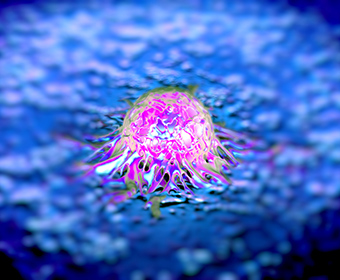
(Sept. 25, 2017) -- Jing Yong Ye, professor of biomedical engineering at The University of Texas at San Antonio (UTSA), has received a two-year, $354,617 grant from the National Institutes of Health’s National Cancer Institute to support the development of his noninvasive method of detecting prostate cancer.
Ye’s research team has been working on the development of a novel microscope based on a photonic crystal biosensor to detect the cancer through a urine sample. It will significantly improve accuracy compared to the approach used in current clinical practice.
Prostate cancer is the second most prevalent type of cancer, and the third leading cause of cancer-related deaths, in men. Early detection is key to survival, which is why doctors are required to screen all men over the age of 50 for the disease.
To screen patients for prostate cancer, medical professionals take a blood sample and look for prostate-specific antigen (PSA). If a high level of PSA is found, the patient is suspected to have prostate cancer and required to have a prostate biopsy.
Unfortunately, PSA tests are far from providing satisfactory diagnoses and result in a large number of unnecessary prostate biopsies due to a high false-positive rate. This is because PSA elevation may also occur in men with infection and chronic inflammation or benign prostatic hyperplasia.
“False positive diagnoses are very common in prostate cancer tests,” Ye said. “As a result, a patient may undergo a biopsy he doesn’t need, which is painful and could cause an infection. Also, because prostate cancer is highly heterogeneous and even multicore prostate biopsy only samples a few local areas, it can easily be missed by clinicians.”
Since about 70 percent of men who go through the biopsy process are found to be cancer-free, Ye wanted to look for a better way. His research team will develop a noninvasive imaging approach to check urine samples, since cells from the prostate are shed into urine naturally.
“The system we are developing utilizes a sensitive biosensor, which allows us to distinguish cancer cells from normal cells based on a unique feature of the cells,” he said. “If you can detect a cancer cell, you’re starting from a more precise place and you can give a more accurate diagnosis.”
Ye’s laboratory develops cutting edge tools based on different biosensors, optical imaging methods and nanobiotechnology to address critical issues in biomedical engineering research and applications.
“We need to use every weapon in our arsenal to attack this disease,” Ye said. “It’s important to think outside the box and use innovation to address these critical issues.”
UTSA is recognized as one of the top five young universities in the nation by Times Higher Education.
Learn more about the UTSA Department of Biomedical Engineering.
Connect with UTSA online at Facebook, Twitter, YouTube, Instagram and LinkedIn.
UTSA Today is produced by University Communications and Marketing, the official news source of The University of Texas at San Antonio. Send your feedback to news@utsa.edu. Keep up-to-date on UTSA news by visiting UTSA Today. Connect with UTSA online at Facebook, Twitter, Youtube and Instagram.
Move In To COLFA is strongly recommended for new students in COLFA. It gives you the chance to learn about the Student Success Center, campus resources and meet new friends!
Academic Classroom: Lecture Hall (MH 2.01.10,) McKinney Humanities BldgWe invite you to join us for Birds Up! Downtown, an exciting welcome back event designed to connect students with the different departments at the Downtown Campus. Students will have the opportunity to learn about some of the departments on campus, gain access to different resources, and collect some giveaways!
Bill Miller PlazaCome and celebrate this year's homecoming at the Downtown Campus with food, games, giveaways, music, and more. We look forward to seeing your Roadrunner Spirit!
Bill Miller PlazaThe University of Texas at San Antonio is dedicated to the advancement of knowledge through research and discovery, teaching and learning, community engagement and public service. As an institution of access and excellence, UTSA embraces multicultural traditions and serves as a center for intellectual and creative resources as well as a catalyst for socioeconomic development and the commercialization of intellectual property - for Texas, the nation and the world.
To be a premier public research university, providing access to educational excellence and preparing citizen leaders for the global environment.
We encourage an environment of dialogue and discovery, where integrity, excellence, respect, collaboration and innovation are fostered.